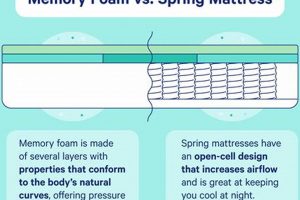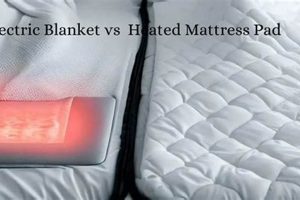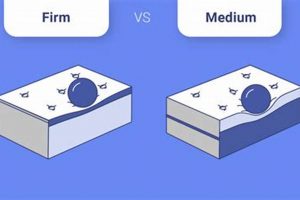The terms “twin” and “single” are commonly used interchangeably to denote a mattress size designed to accommodate one individual. This standard bed dimension typically measures around 38 inches wide and 75 inches long, making it suitable for children transitioning to a larger bed, teenagers, or single adults with limited space. For example, a child moving from a crib might use this size mattress in their first “big kid” bed.
This mattress size offers advantages in terms of space efficiency and affordability. Its compact footprint makes it ideal for smaller bedrooms, guest rooms, or studio apartments where maximizing floor area is essential. Historically, this size has been a popular choice for bunk beds and shared children’s rooms, offering a comfortable sleeping surface without overwhelming the available space. The lower price point, compared to larger mattresses, also makes it an accessible option for budget-conscious consumers.
Understanding the features and applications of this bed dimension is crucial when selecting the appropriate sleep solution. The subsequent discussion will delve into its specific characteristics, compare it with alternative mattress sizes, and outline the factors to consider when making a purchase decision.
Guidance on Mattress Selection
The following guidance provides essential considerations for purchasers evaluating this mattress dimension, emphasizing factors that optimize comfort, support, and suitability.
Tip 1: Assess Spatial Constraints: Precisely measure the intended bedroom area to ensure the mattress fits comfortably without impeding movement. Allow adequate clearance around the bed for accessibility.
Tip 2: Evaluate Sleeper Profile: Consider the occupant’s height and sleeping style. Taller individuals may benefit from an extended variant to prevent discomfort or restricted movement during sleep.
Tip 3: Prioritize Support and Comfort: Examine mattress construction materials, such as innerspring coils, memory foam, or latex. Select a firmness level that aligns with individual preferences and postural needs.
Tip 4: Investigate Edge Support: Evaluate the stability of the mattress edges. Robust edge support prevents sagging and maximizes the usable sleeping surface, particularly for individuals who tend to sleep near the edge.
Tip 5: Research Warranty and Return Policies: Scrutinize the manufacturer’s warranty and return policies. Opt for brands offering comprehensive coverage and trial periods to ensure satisfaction.
Tip 6: Consider Foundation Compatibility: Verify that the mattress is compatible with the intended bed frame or foundation. Incompatible pairings may compromise support and shorten the mattress’s lifespan.
Tip 7: Evaluate Material Allergies: If the intended occupant has known allergies, research the materials used in the mattress construction. Hypoallergenic options are available to mitigate potential allergic reactions.
Adhering to these guidelines will enable purchasers to make informed decisions, resulting in an optimized sleep experience and a durable, suitable mattress choice.
The subsequent section will offer a comparative analysis of this mattress size against other common dimensions, facilitating a broader understanding of available options.
1. Dimensions
Mattress dimensions are fundamental when considering the “twin vs single mattress” choice, directly affecting suitability for particular spaces and individual users. Specific measurements determine compatibility and comfort.
- Standard Size
The nominal dimensions of a “twin” or “single” mattress are approximately 38 inches in width and 75 inches in length. These measurements are generally consistent across manufacturers, although slight variations may occur. Accurate dimension verification is recommended before purchase to ensure a proper fit within the intended bed frame.
- Space Utilization
The compact size of a “twin” or “single” mattress makes it advantageous in smaller bedrooms, guest rooms, or studio apartments where space is at a premium. Its dimensions allow for efficient floor plan utilization compared to larger mattress sizes. Its adoption is appropriate when floor space is more important.
- Occupant Suitability
The specified dimensions are generally appropriate for children, teenagers, or single adults of average height. Taller individuals may find the length restrictive and should consider extended versions. Evaluating occupant height relative to the mattress length is critical to prevent discomfort.
- Variations and Customization
While standard dimensions prevail, some manufacturers offer variations in length or width. These variations can accommodate specific needs, such as extra length for taller individuals or narrower width for unconventional bed frames. Customization options are available, but generally at a higher cost.
In summary, the dimensions of a “twin” or “single” mattress are a primary determinant of its applicability. The standard measurements are designed for space efficiency and compatibility with a broad range of users, but careful assessment of individual needs and spatial constraints is essential for optimal selection.
2. Space Efficiency
The “twin” or “single” mattress is intrinsically linked to space efficiency due to its compact dimensions. Its reduced footprint, compared to larger mattress sizes, directly correlates with increased available floor space within a given room. This becomes particularly significant in smaller living spaces, such as apartments, dormitories, or shared bedrooms where maximizing usable area is a priority. The adoption of this mattress can result in a more functional and less cluttered environment.
The practical implications of space efficiency extend beyond mere aesthetics. For instance, in a child’s bedroom, the use of this mattress size allows for the inclusion of additional furniture, such as a desk or play area, which would otherwise be infeasible with a larger bed. Similarly, in a guest room, it permits comfortable accommodation without unduly compromising the room’s overall functionality. This careful consideration of mattress size allows for optimization of space utilization, enhancing the usability of the living area.
In conclusion, the inherent space-saving characteristics of a “twin” or “single” mattress make it a favorable option for individuals and households prioritizing efficient use of available space. While considerations of occupant size and comfort remain paramount, the ability to maximize floor area underscores the practical significance of this dimension in specific living environments. This advantage represents a notable attribute when evaluating various mattress options.
3. Cost Considerations
The financial implications associated with a “twin” or “single” mattress represent a significant factor in purchasing decisions. A direct correlation exists between mattress size and price; smaller dimensions generally equate to lower production costs, resulting in a more accessible price point for consumers. This cost advantage stems from reduced material usage and simplified manufacturing processes compared to larger mattress sizes. The comparatively lower cost of a “twin” or “single” mattress makes it a practical option for budget-conscious individuals, families furnishing children’s rooms, or outfitting guest accommodations on a limited budget. For example, a student setting up a dorm room or a family furnishing a bunk bed set might find the affordability of this size particularly appealing.
Beyond the initial purchase price, cost considerations extend to associated expenses. Bed frames, bedding, and other accessories for “twin” or “single” mattresses tend to be less expensive than their counterparts for larger sizes. This cost reduction further enhances the overall financial attractiveness of this mattress option. Furthermore, in situations requiring multiple beds, such as in shared children’s rooms or summer camps, the cumulative cost savings associated with choosing “twin” or “single” mattresses can be substantial. The operational impact from cost perspective is lower material consumption for the supplier, making it affordable to the consumer.
In conclusion, the cost-effectiveness of a “twin” or “single” mattress is a primary driver in its widespread adoption. While factors such as comfort and space requirements also play critical roles in the selection process, the financial advantages associated with this mattress size cannot be overlooked. This consideration, coupled with its practical suitability for specific applications, solidifies its position as a cost-conscious and pragmatic choice. The understanding of the economical factors are a crucial aspect in selection.
4. Intended Occupant
The intended occupant is a primary determinant in selecting a “twin” or “single” mattress. The size and weight of the sleeper directly impact the level of comfort and support provided by the mattress. A child transitioning from a crib, for example, is ideally suited for this mattress size due to its appropriate dimensions and supportive surface. Conversely, an adult exceeding a certain height or weight threshold may find the same mattress inadequate, leading to discomfort and potentially compromising sleep quality. The correlation between the intended user’s physical attributes and the mattress’s suitability is therefore direct and consequential.
This consideration extends beyond simple physical size. The sleeping habits and preferred sleep position of the occupant also influence the optimal mattress choice. A side sleeper, for instance, may require a mattress with enhanced pressure relief to alleviate stress on the hips and shoulders, while a back sleeper may benefit from firmer support to maintain spinal alignment. Children or teenagers, whose bodies are still developing, require mattresses that provide adequate support for proper skeletal growth and posture. Neglecting the intended occupant’s specific needs can result in restless sleep, physical discomfort, and long-term health issues, underlining the practical significance of this factor.
In summary, the selection of a “twin” or “single” mattress necessitates a thorough evaluation of the intended occupant’s size, weight, sleeping habits, and physical requirements. A mismatch between the occupant and the mattress can negatively impact sleep quality and overall well-being. This aspect should be prioritized over other factors, such as cost or aesthetics, to ensure that the chosen mattress provides the necessary comfort, support, and longevity for the intended user. Furthermore, as the occupant grows or their needs change, reevaluation of the mattress suitability is advisable.
5. Bed Frame Compatibility
Ensuring bed frame compatibility is paramount when selecting a “twin vs single mattress.” A mismatch can compromise structural integrity, reduce mattress lifespan, and negate the intended comfort benefits. The following points detail key facets of this essential consideration.
- Standard Dimensions and Support Systems
Frames designed for “twin” or “single” mattresses adhere to specific dimensional standards (approximately 38 inches by 75 inches). The frame’s support systembe it slats, springs, or a solid platformmust adequately distribute weight and prevent sagging. Deviations from these standards may necessitate modifications or render the frame unsuitable.
- Frame Material and Load Capacity
The material composition of the bed frame directly influences its load-bearing capacity. Metal frames generally offer greater support than wooden frames, particularly for heavier individuals. The frame’s construction should withstand the combined weight of the mattress and the intended occupant without exhibiting signs of stress or instability.
- Headboard and Footboard Attachment
Secure attachment points for headboards and footboards are critical for structural stability and aesthetic appeal. Bed frames intended for “twin” or “single” mattresses often feature pre-drilled holes or brackets designed to accommodate standard headboard and footboard configurations. Incompatibility in attachment mechanisms may require adapters or modifications.
- Clearance and Accessibility
Adequate clearance between the bed frame and the floor facilitates cleaning and storage. The height of the frame also affects accessibility for individuals with mobility limitations. When selecting a “twin” or “single mattress,” ensure the frame’s dimensions provide sufficient clearance and ease of access for the intended user.
Proper bed frame compatibility guarantees optimal mattress performance and longevity. Neglecting this aspect can result in premature wear, compromised support, and potential safety hazards. Therefore, thorough assessment of dimensional and structural compatibility is essential prior to purchase.
6. Availability
The market presence of “twin vs single mattress” options plays a pivotal role in consumer choice. Readily accessible options, diverse product ranges, and comprehensive distribution networks significantly impact purchase decisions and overall satisfaction.
- Retail Presence
Brick-and-mortar stores, ranging from large department chains to specialty mattress retailers, significantly contribute to “twin vs single mattress” availability. These physical locations allow consumers to directly assess product features, compare models, and receive expert advice. Conversely, geographical limitations and restricted operating hours may constrain accessibility for some consumers. The density of retail outlets directly correlates with consumer access to purchase.
- Online Marketplaces
E-commerce platforms expand “twin vs single mattress” availability exponentially. Online retailers offer extensive product catalogs, competitive pricing, and convenient delivery options, overcoming geographical barriers and time constraints. However, the absence of tactile evaluation and reliance on digital representations may pose challenges for discerning consumers. The digital marketplace creates ease of comparison to consumers to different products.
- Manufacturer Direct Sales
Direct-to-consumer sales models, facilitated by manufacturers’ online platforms or showrooms, offer a curated selection of “twin vs single mattress” options. These channels often feature competitive pricing, personalized customer service, and detailed product information. However, the limited product range and potential for biased marketing may restrict consumer choice compared to broader retail outlets. The benefits are usually cost-effective for consumers in comparison.
- Supply Chain Dynamics
The efficiency of the supply chain directly impacts “twin vs single mattress” availability. Inventory management, production capacity, and distribution logistics determine the speed and reliability with which products reach consumers. Disruptions in the supply chain, such as material shortages or transportation delays, can lead to limited availability and price fluctuations. Supply chains have a direct correlation between consumer purchase decisions.
The interaction of these facets dictates the overall accessibility of “twin vs single mattress” options. A robust combination of retail presence, online marketplaces, manufacturer direct sales, and efficient supply chains ensures that consumers have a wide range of choices, competitive pricing, and convenient access to the products that best meet their needs. Disruptions in any of these areas can significantly limit availability and impact consumer satisfaction. These components have a direct impact on selection and purchase decision.
Frequently Asked Questions About Twin vs Single Mattresses
The following questions address common concerns and misconceptions surrounding twin and single mattresses. These responses aim to provide clarity and facilitate informed decision-making.
Question 1: What is the precise size of a twin or single mattress?
A twin or single mattress typically measures approximately 38 inches wide and 75 inches long. Minor variations may occur depending on the manufacturer.
Question 2: Is a twin mattress suitable for adults?
A twin mattress may accommodate some adults comfortably, particularly those of average height. Taller individuals may find the length constricting.
Question 3: What are the primary benefits of choosing a twin mattress over larger sizes?
Key advantages include space efficiency, lower cost, and suitability for children’s rooms or smaller guest rooms.
Question 4: Can a twin mattress support the weight of two individuals?
A twin mattress is designed for single occupancy. Exceeding its weight capacity may compromise support and accelerate wear.
Question 5: What type of bed frame is required for a twin mattress?
A bed frame specifically designed to accommodate twin-size mattresses is necessary. Dimensions and support systems must align with the mattress specifications.
Question 6: Where can twin mattresses be purchased?
Twin mattresses are widely available at furniture stores, department stores, and online retailers. Availability may vary depending on the manufacturer and retailer.
These FAQs provide a foundational understanding of essential considerations related to twin and single mattresses. Informed decisions should be based on a thorough evaluation of individual needs and circumstances.
The subsequent section will provide details on maintenance and care to prolong the lifespan of this mattress type.
Concluding Remarks on Twin vs Single Mattress Selection
The preceding discussion has illuminated the salient characteristics and considerations pertaining to “twin vs single mattress” selection. Key aspects, including dimensions, space efficiency, cost, intended occupant, bed frame compatibility, and availability, directly influence the suitability of this mattress type for specific applications. Recognizing these factors facilitates a more informed and optimized purchasing decision.
The prudent selection of a mattress requires careful evaluation of individual needs and circumstances. While “twin vs single mattress” options offer compelling advantages in terms of space and cost, proper assessment of user requirements and spatial constraints remains paramount. A well-informed decision ensures optimal comfort, support, and longevity, ultimately contributing to improved sleep quality and overall well-being. Continued research and awareness of evolving mattress technologies are encouraged to maintain informed decision-making practices in the future.







